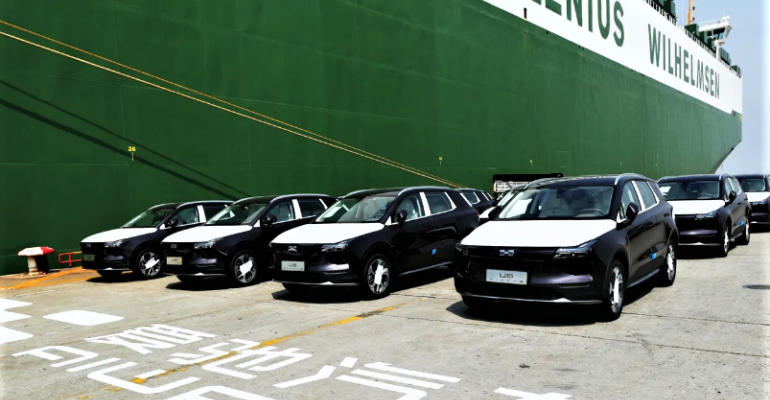BRUSSELS – U.S. automakers finally have more certainty about the European Union technical rules designed to ensure its 27 member states only allow sales of zero-emission vehicles (ZEVs) from 2035. But an American industry expert says Chinese competition could be strong.
EU transport ministers on March 28 formally approved an October 2022 political deal with the European Parliament on shifting to 100% emission-free car and van sales by 2035. The agreement, which Parliament rubber-stamped in mid-February, also includes interim 2030 targets of 55% CO2 emission reductions for new cars and 50% for new vans compared to 2021 levels.
But automakers selling 25% zero- and low-emission vehicles (ZLEV) for cars and 17% for vans from 2025 through 2029 could see CO2 targets eased under a regulatory incentive mechanism.
Ministerial approval followed a three-week delay after German Chancellor Olaf Schulz suddenly announced that Germany would block the deal because it did not allow for synthetic e-fuels as a zero-emission option.
German carmaker Porsche, part of the Volkswagen Group – and the government itself – have invested heavily in synthetic fuels and would be hard hit by an outright ban on the internal-combustion engine. European Commission and German negotiators ended the deadlock with a compromise that leaves October’s deal intact but adds a pledge from the EU executive to draft an additional EU proposal allowing registration of cars running on CO2-neutral fuels after 2035.
“This law is not a battery mandate. It’s a zero-emissions standard,” Julia Poliscanova (pictured, below left), senior director, vehicles and e-mobility at the not-for-profit Transport and Environment (T&E) green lobbying group, tells Wards. Poliscanova dismisses e-fuels as “niche,” with T&E estimating it would cost over twice as much to fill up with synthetic fuel than standard gas.
 While EVs currently are expensive in Europe, Poliscanova stresses that “the whole point of this law is it will push carmakers to mass (ZEV/LZEV) production. This is how you make cars mass market,” adding, “there is nothing inherently more expensive about a BEV – it’s simply not on scale.”
While EVs currently are expensive in Europe, Poliscanova stresses that “the whole point of this law is it will push carmakers to mass (ZEV/LZEV) production. This is how you make cars mass market,” adding, “there is nothing inherently more expensive about a BEV – it’s simply not on scale.”
But will U.S. automakers benefit from the future European ZEV market? A spokesperson for Autos Drive America says the U.S. already does export a significant number of EVs to the EU.
According to the latest U.S. Census Bureau trade data, last year the U.S. exported 81,000 new EVs to the EU, over one-third of the 221,600 total vehicles the US exported to the EU in 2022. This compares with the 114,962 EVs (both battery-electric and hybrid vehicles) exported to the bloc in 2021, or some 42% of the total 273,900 new U.S. vehicle exports to the EU.
“If our members want to export to the EU, as many of them do, they’ll need to comply with the requirements there. So as new EV models come to production facilities here, I’d imagine that exports to the EU would naturally increase,” the Autos Drive America spokesperson says.
But how many? “Yes, there will be (zero- and low-emission) vehicles built in the U.S. and sold in Europe, but not in high quantities,” Brett Smith, research fellow at the Center for Automotive Research, in Ann Arbor, MI, tells Wards. “You’re more likely to see vehicles built in China. They expect to be much bigger” in the European market.
But Smith notes “it will be interesting to see if European Union countries will allow that…it really depends how aggressive the Chinese get.” He predicts the EU will introduce “very significant local content criteria” to protect domestic automakers.
The Chinese export threat is real. While domestic vehicles dominate, Chinese automakers already account for 10% of Europe’s EV market, according to BloombergNEF.
Similarly, the EU’s statistical office Eurostat shows EU imports of all-electric vehicles from China has been increasing sharply by value in 2021 compared with 2017 – €11.4 billion ($12.5 billion) compared with €460 million ($500 million). China (43%) held the largest share of these EV imports in 2021, followed by South Korea (20%), the U.S. (17%) and Mexico (10%).
 Smith (pictured, left) underscores: “We drive a different type of vehicle here to other parts of the world, so vehicles built here are intended to be driven here.” Even when exporting, “we build them where we sell them” partly because the U.S. is a higher-cost manufacturing base and “we won’t compete if we export.”
Smith (pictured, left) underscores: “We drive a different type of vehicle here to other parts of the world, so vehicles built here are intended to be driven here.” Even when exporting, “we build them where we sell them” partly because the U.S. is a higher-cost manufacturing base and “we won’t compete if we export.”
He says many North American exports come from Mexico, because it is a low-cost manufacturing base and has free-trade agreements with many more countries than the U.S.
Smith does not expect the U.S. Inflation Reduction Act (IRA) to boost the number of EVs exported. “If you look at the Detroit manufacturers, Ford, GM and Stellantis – GM has pulled out of Europe for the most part; Ford will build its vehicles in Europe; and Stellantis is headquartered in the Netherlands (and) so will use European facilities,” he says. “The other part of this is, just as IRA will create incentives for U.S. manufacturers to build plants in the U.S., Europe will have its own incentives for plants.





